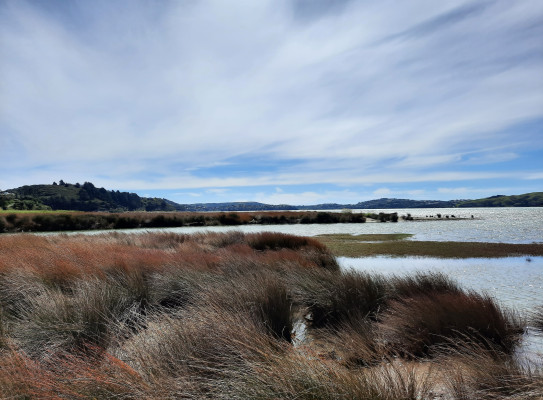
Blue carbon potential of New Zealand coastal saltmarshes

Coastal saltmarshes are among the most productive ecosystems in the world. They sequester and store a significant amount of carbon in their soils where it may remain for millennia, mitigating increasing carbon dioxide (CO₂) concentrations in the atmosphere.
Overview
Saltmarshes are productive ecosystems that store carbon and provide critical services such as flood protection and water filtration and support regional biodiversity.
Despite their recognised importance as nature-based solutions for disaster and climate resilience, we know little about their carbon sequestration potential in Aotearoa New Zealand, and how these ecosystems are likely to respond to rising sea levels.
Victoria University of Wellington (VUW) researcher Olya Albot will lead the research as part of her PhD – “Carbon sequestration potential of New Zealand’s saltmarshes and resilience to future impacts of sea level rise”. She is supervised by Richard Levy (GNS Science and VUW) and VUW’s Adjunct Researcher Dr Joss Ratcliffe and is partnering with the Department of Conservation Te Papa Atawhai on this project.
The project aims to
- investigate the carbon sequestration potential of three saltmarsh sites in Rangaunu Harbour, Northland, a saltmarsh at the Pūkorokoro-Miranda Reserve, Firth of Thames, and a saltmarsh at the Pāuatahanui Wildlife Reserve, Wellington
- quantify future sea-level rise impacts on coastal wetlands (mangrove-saltmarsh environments) in Rangaunu Harbour
- evaluate the potential voluntary and regulatory market access to carbon, resilience and biodiversity programmes for our coastal wetlands
To achieve these aims we will
- collect soil cores across a range of site types including:
- pristine – little human influence on the ecosystem over the last century
- disturbed – where human activities have resulted in ecosystem degradation
- modified – such as draining and converting to another land use
- restored – such as reintroduction of tidal flow to a previously damaged saltmarsh
The cores will then be analysed for carbon stocks and sequestration rates, and other additional parameters which will be used to reconstruct the environmental history of the saltmarsh environments.
The project
The carbon connection
Aotearoa New Zealand recognises the potential of wetlands in carbon markets and government emission reduction plans. However, the carbon sequestration potential and the response of coastal wetlands to sea level rise have not been adequately investigated. The Climate Change Commission has highlighted this as an area requiring further research.
This project has the potential to provide essential data needed to include coastal wetlands in New Zealand’s Emissions Trading Scheme and other pathways that aim to implement climate change policy and mitigate our greenhouse gas emissions.
The sea-level rise connection
Coastal wetlands with mixed mangrove-saltmarsh vegetation are particularly vulnerable because sea-level rise can promote mangrove encroachment on saltmarshes, reducing overall wetland biodiversity.
We’ll assess the sensitivity of coastal wetlands to rising sea levels under several coastal management scenarios. These include national sea-level rise projections for Northland:
These incorporate the latest research on the future response of the Earth’s ice sheets, as well as local non-climatic influences.
Our research will indicate how sea-level rise will compromise the extent of our mangrove-saltmarsh environments and help identify ways of mitigating the effects of sea level rise, such as using saltmarshes as a nature-based solution vs. stop banks.
These outputs will inform coastal adaptation and marine protection planning and highlight the valuable role that thriving biodiversity can play in our approach to mitigating climate change.

Research project details
Collaborators: Victoria University of Wellington, Department of Conservation Te Papa Atawhai, GNS Science
Duration
2021–2024
Funding platform
Status
Starting 2021
Leader
Olya Albot, Victoria University of Wellington
Funder
Victoria University of Wellington, Department of Conservation Te Papa Atawhai, GNS Science